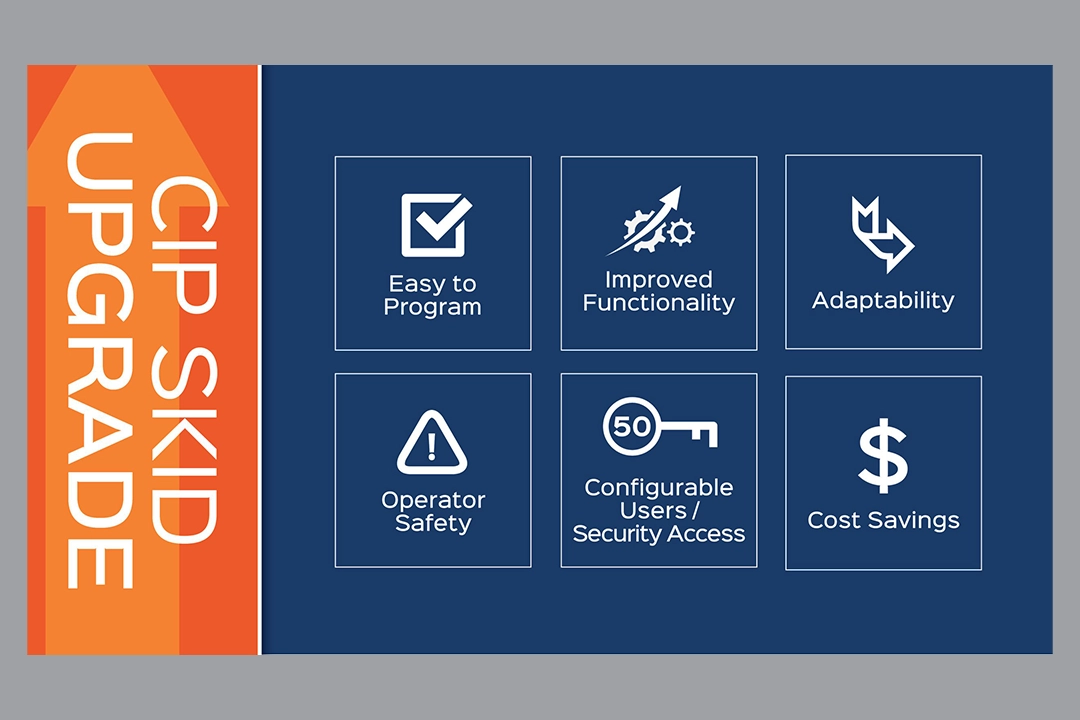As food, beverage and pharmaceutical manufacturing processes change and operations grow, a CIP skid may require modifications to perform new tasks. Sani-Matic’s Tactical Solutions team specializes in finding the right CIP system solution for ever-evolving processes.
Sani-Matic’s Tactical Solutions Manager Micah Muller and Tactical Solutions Engineer Chris Raulin, discussed the top reasons for updating a CIP skid.
Top Reasons to Upgrade a (CIP Skid) System
- An older system’s performance doesn’t meet expectations
- An older system that can’t perform the necessary functions
- A previously owned Sani-Matic CIP skid that needs to be upgraded to a new owner’s process
- Achieve cost savings with an upgraded, optimized system
- Adding a tank for water reuse or new chemical cleaning needs (i.e., acid)
- Replace an older PLC that doesn’t support current communications (Ethernet)
“When we get a call about a system that’s not functioning as it should, the first thing we do is audit the system to identify opportunities for improvement,” said Muller. “Then we make recommendations based on our findings.”
In one example, Raulin recalled a customer who contacted Sani-Matic to repurpose an old CIP skid for a new process. “We conducted a complete evaluation of this system and concluded the best solution was to upgrade it instead of replace it,” he said. “Just because it’s an old skid, doesn’t mean it’s no longer a good skid.”
The skid being evaluated was about ten years old and had been damaged when it was removed from a closing facility and before it was sold on the secondary market. Wires had been cut, a leg was broken, and some components were lost or repurposed to other equipment. The system was also operating with an outdated HMI, it needed an additional tank and updated functionality for the new process.
Sani-Matic engineers repaired the broken parts and replaced the missing components. They added a new tank and valves, programmed a new PLC and updated the HMI.
“All in all, we got everything done in one job for less than it would cost for a new system.”
PLCs: Reprogram or Replace?
Often, PLCs are the primary components in need of an update. Outdated PLCs can be difficult to use, incompatible with modern communication methods, and no longer supported.
The question that the Sani-Matic Tactical Solutions Team faces regularly, is whether it makes most sense to reprogram the existing PLC or replace it with a new one.
Muller discussed a situation where a customer contacted Sani-Matic with a request to upgrade a relatively new CIP skid that had been produced by another manufacturer. The customer’s process had changed, but the original CIP manufacturer did not do its own programming.
In this case, Sani-Matic used the existing PLC and rewrote the programming and updated the instrumentation to meet the customers changing process needs.
In cases of older PLCs, it’s often best to replace it with a new one.
The Top 5 Functionalities Gained with a New PLC/HMI
- Configurable Users. Easy to add new users (up to 50) with individual usernames and passwords.
- Meet Food Safety Standards. When a PLC is upgraded, more current instrumentation can be added to better monitor TACT (time [cycle length], action [flow, pressure, etc.], chemical, and temperature).
- Easy to Add/Edit Recipes. Operators no longer have to refer to an excel spreadsheet to look up operation codes. A new, easy-to-use HMI allows for quick editing that adapts the recipe to an updated, automatic sequence of steps, efficiently addressing any process changes.
- Operator Safety Improvements.
- Cost-Savings, Helping Operators Meet Savings Goals. Chemical savings with conductivity analyzers and water savings with an additional tank for reuse.
Thinking Ahead. Tips from the Tactical Solutions Team.
After years of experience servicing CIP skids, the Tactical Solutions Team had some helpful advice.
Raulin emphasized that contacting the Sani-Matic team to look at a used system before purchasing it can save equipment buyers a lot of headaches. “If there isn’t time or a budget for an in-person review, we can examine images if you have them, or check our records for any equipment audits or services we may already have on file for the system,” he added.
Raulin also suggested that buyers verify all parts and instrumentation will come with the used equipment. “Quite often you end up paying 80% of a new system with the upgrades that need to be done to a pre-owned system, especially if the necessary parts are stripped from the equipment,” stated Raulin.
Raulin recommends looking at a cost analysis for an upgrade versus new system. “As a service guy, I don’t make commission on a new system sale,” Raulin said. “My goal is to find the right solution, whether an upgrade to an old system or recommending a new one. If it is an upgrade, I want to do it right, so you have confidence in our service.”
Choosing Not to Upgrade, a Cautionary Tale
If the decision is made to purchase replacement parts for a current PLC instead of upgrading to a new PLC/HMI, it is important to note that replacement parts may be obsolete and only available on eBay, which do not have a guarantee.
Last, but not least, if the choice is made not to upgrade, and the CIP system breaks down, production will stop for much longer than a planned upgrade. “If customers can’t clean, they can’t make product,” Muller said. “Our entire program was created to help prevent costly downtime for our customers, and we are very committed to that.”


